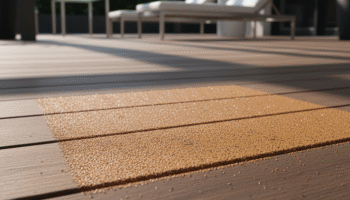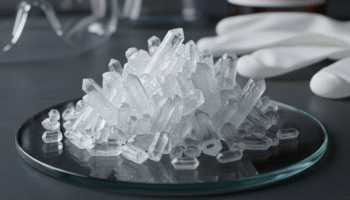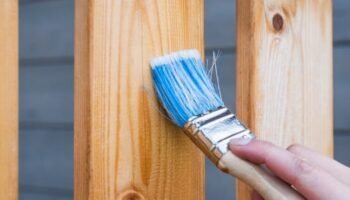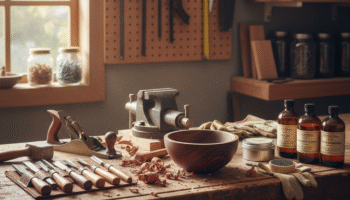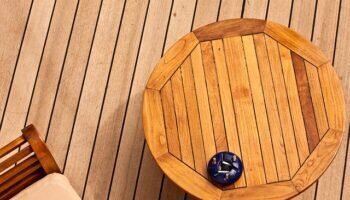When to Stain & What Products Work
If you just built a brand-new green deck and you’re itching to stain it now, take a breath. The #1 cause of ugly peels and blotches on pressure-treated (PT) lumber is staining too early. I’ve rescued dozens of “failed stain” decks where the product wasn’t the problem—moisture and chemical residue were. This guide gives you the exact timeline, tests, and products that actually work on PT wood so your first job lasts.
Understanding Pressure-Treated Wood Properties
Chemical Treatment Process Explained
PT lumber is infused under pressure with water-borne preservatives—primarily copper-based systems—to resist rot and insects. That pressure cycle drives a lot of water deep into the fibers. Until that water and excess treatment migrate out (leach/evaporate), stains can’t properly penetrate.
In my projects, I always explain that the green tint isn’t just color—it’s chemistry that needs time to settle before finishing.
Why PT Lumber Needs Special Care
The same copper compounds that protect the wood can repel or inhibit some coatings. Add high internal moisture, and many stains simply sit on the surface and shear off with UV and foot traffic.
The biggest PT mistake is timing—build your wait window, water-bead test, and first coat into the climate plan in the Exterior Wood Care Guide, then follow deck-specific steps in the Deck Care Encyclopedia. When you’re ready to choose a product, compare durability and recoat effort here: Deck Sealer vs Stain.
Common Types: ACQ, CA-B, MCQ
- ACQ (Alkaline Copper Quaternary): Strong protection; more corrosive to fasteners—use hot-dip galvanized or stainless.
- CA-B / CA-C (Copper Azole): Similar performance with less amine content.
- MCQ (Micronized Copper Quat): Uses copper particles; slightly different interaction with coatings.
Green vs Brown PT Wood Differences
Color is from the dye in the treatment; it doesn’t change the waiting rule. Brown PT can hide early wear better, but it still needs the same moisture drop before staining.
The Critical Waiting Period: When Can You Stain?
Why You Must Wait (Chemical Leaching)
Fresh PT wood expels treatment solution and water for months. Stain applied too soon can’t anchor in the cell walls—it floats, then flakes.
I’ve seen brand-new decks stained at 4 weeks where the coating literally slid off within 3–6 months. Costly, avoidable, and 100% about timing.
The 3–6 Month Rule Explained
As a baseline, let new PT wood weather 3 to 6 months. Hot/dry climates skew shorter; cool/shaded or coastal areas skew longer.
Testing for Readiness (The Water Bead Test)
Sprinkle water on bare boards:
- Beads up after 2–3 minutes → still too wet.
- Absorbs within ~5 minutes and darkens evenly → good sign to proceed.
Climate Impact on Drying Time
- High humidity or shade: expect the long end (5–6 months).
- Full sun with airflow: closer to 3 months.
- After rain or washing: let wood dry 48 hours minimum before coating.
New “Kiln-Dried After Treatment” (KDAT) PT Lumber
KDAT is pressure-treated then kiln-dried to reduce moisture. You can often stain immediately once surface prep is done. Always verify it’s truly KDAT and still perform the bead test.
Best Stains for Pressure-Treated Wood
Oil-Based vs Water-Based on PT Lumber
- Oil-based penetrating stains: Best for PT; low surface film, deeper bite, easier maintenance.
- Water-based/acrylics: Can re-saturate the wood and form films that peel sooner on fresh PT; work better on well-seasoned PT or as solid-color options after year 2+.
My long-term winners on PT are penetrating oils. They move with the wood and touch-ups blend invisibly.
Top 8 PT-Compatible Stain Products
(Always follow each manufacturer’s PT guidance.)
- TWP 1500 Series — deep penetration, strong UV hold for semi-transparent.
- Armstrong-Clark — high-oil content; forgiving application, great for softwoods.
- Ready Seal — contractor-friendly; no lap marks when applied correctly.
- DEFY Extreme (oil-modified) — good durability with easy maintenance cycles.
- Cabot Australian Timber Oil — rich penetration, warm tone on PT pine.
- Penofin Ultra / Blue Label — Brazilian oils; excellent water repellency.
- Olympic Elite — solid value; consider after the wood has seasoned.
- Bainbridge / PPG Proluxe penetrating lines* — use penetrating options, not film-forming deck finishes on fresh PT.
Why Some Stains Fail on PT Wood
- Applied over wet or still-leaching lumber.
- Film-forming deck coatings on fresh PT (they look great day 1 and then shear).
- Skipped surface prep (mill glaze, alkaline residue).
- Too thick; oils need to soak in, not sit on top.
Penetrating vs Film-Forming for PT
- Penetrating (semi-transparent/transparent oils): best early-life PT choice.
- Film-forming (solid stains/paints): wait until year 2+ and ensure very dry wood—or expect maintenance like a painted surface.
Step-by-Step First-Time Staining Guide
Pre-Treatment Cleaning (Mill Glaze Removal)
New boards often have “mill glaze” (compressed, slightly burnished fibers). Clean with oxygen bleach (sodium percarbonate) or a deck cleaner to open the surface. Rinse thoroughly.
Neutralizing Chemical Residue
Brighten with oxalic acid to remove copper discoloration and neutralize alkalinity. This evens out color and improves penetration. Rinse and dry 48 hours.
My “never-skip” sequence: oxygen bleach wash → oxalic brightener → 48-hour dry. It’s the difference between a 1-season and a 3-season result.
Proper Application Technique
- Work in shade on cool boards (avoid hot sun).
- Stir, don’t shake; maintain a wet edge.
- Apply thin, even coats with pad/brush; back-brush into the grain.
- Wipe excess in 10–15 minutes—no shiny puddles.
Drying & Curing Time
Most oils are dry-to-touch in 6–24 hours; avoid heavy traffic and furniture for 48–72 hours depending on weather.
Maintenance Schedule for PT Decks
Year 1–2: Initial Protection Phase
Expect a light recoat where UV is harsh. Clean and apply a refresher coat before heavy graying sets in.
Year 3–5: Established Maintenance
Clean annually; recoat every 24–36 months as needed. Spot-treat high-traffic zones sooner.
Year 6+: Mature Deck Care
Boards stabilize; color shifts slower. You may stretch intervals if shade/covered, but continue yearly inspections.
Signs It’s Time to Re-Stain
Graying, water no longer beads, fuzzing fibers after wash, or color faded in traffic lanes.
I tell clients: when a splash test no longer darkens evenly or water soaks instantly, it’s time.
Common PT Lumber Problems & Solutions
Green Tint Bleeding Through Stain
Use oxalic brightener before staining; choose a warming tone (cedar/amber) and a semi-transparent oil for better masking.
Cupping & Warping Issues
Ensure board gap (⅛–¼»), face-screw boards, and keep the underside ventilated. Avoid trapping moisture with rugs or planters.
Checking & Splitting
Normal as PT dries. Keep end grains sealed; avoid heavy film finishes that magnify checks.
Fastener Corrosion
ACQ/CA chemistries are aggressive to plated steel. Use hot-dip galvanized (G-185) or stainless fasteners and connectors.
PT Wood vs Other Decking: Maintenance Comparison
- PT Pine: Lowest upfront cost, most frequent early maintenance (2–3 years).
- Cedar/Redwood: Better natural stability; similar stain cycles but easier prep.
- Composite: No staining, but requires cleaning; heat and mold management.
- PVC: Minimal maintenance; higher initial cost; careful with expansion and heat.
Cost Analysis: PT Lumber Long-Term Care
Over 10 years for a mid-size deck (labor + materials, ballpark):
- PT with penetrating oil maintenance: initial+initial +initial+ every 2–3 years = $$$–$$$$ total.
- Composite/PVC (no staining): initial + $ cleaning = **–$$$$$** total.
PT often wins on lifetime cost if you keep up with light maintenance instead of full repaints.
Environmental & Health Considerations
Modern PT Chemicals (Copper-Based)
Today’s residential PT is copper-based (ACQ/CA/MCQ), not the older CCA for residential surfaces.
Safe Handling Practices
Wear gloves, eye protection, and a dust mask when cutting; collect sawdust and dispose responsibly; never burn PT scraps.
Disposal Regulations
Follow local guidance for treated wood disposal; Check the following sources:
Professional vs DIY PT Deck Staining
- DIY: Lower cost; follow the prep protocol and timing to win.
- Pro: Faster, consistent film build, better color control, and warranty on workmanship.
Product Recommendations by PT Wood Type
- ACQ or CA-B/C: Penetrating oils (TWP 1500, Armstrong-Clark, Ready Seal).
- MCQ: Penetrating oils or oil-modified blends (DEFY Extreme oil-modified).
- KDAT PT: Same products, but you can coat sooner if bead test passes.
Warranty Considerations & What Voids Them
Manufacturers and some lumber warranties expect finishing within 6–12 months. You can void coverage by:
- Staining too early or over wet wood.
- Skipping clean/brighten steps.
- Using film-forming paints on fresh PT.
- Ignoring fastener compatibility (corrosion claims denied).
When in doubt, document moisture tests and keep product receipts.
Staining PT lumber is all about timing + prep + penetration. Wait until the wood passes the water bead test, clean and brighten, then use a penetrating oil with thin, even coats. Maintain lightly and regularly, and your deck will look great years longer—with minimal drama.
Caring for pressure-treated wood follows the maintenance rhythm of the Deck Care Encyclopedia, and surface discoloration issues are covered in Remove Tannin Stains from Wood Siding & Decks.
FAQs
How to tell when pressure treated wood is ready to stain?
Run the water bead test—if water absorbs within ~5 minutes and the wood darkens evenly, you’re ready.
Best oil based stain for new pressure treated deck?
Top performers I use: TWP 1500, Armstrong-Clark, Ready Seal, Cabot ATO, Penofin. Choose a semi-transparent tone for UV + natural look.
Can you stain pressure treated wood too early—problems?
Yes. Expect poor penetration, peeling within months, blotches, and wasted money on rework.
Pressure treated deck care first year maintenance guide?
Let it weather 3–6 months, clean/brighten, then apply a penetrating oil. Plan a light refresher in 18–24 months depending on sun.
Stain compatibility with copper azole treated lumber?
Use penetrating oils; avoid thick films in year 1. Prep with brightener to neutralize copper discoloration.
Kiln dried after treatment pressure treated wood stain immediately?
Often yes, but verify KDAT and still perform the bead test. Do full prep for best results.
Water bead test pressure treated wood—what am I looking for?
Even darkening and no beading after a few minutes. If it beads, wait and retest in 2–4 weeks.
Currently viewing
Pressure-Treated Lumber Care
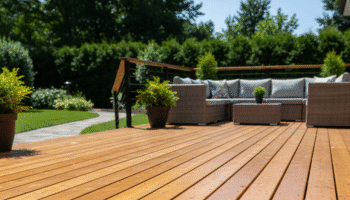
Non-Slip Deck Coatings
Grip Additives vs Textured Stains vs Strips Safety-first, solution-oriented guide to stop slip-and-fall accidents on…
Deck Cleaning Solutions
Oxalic Acid vs. Sodium Percarbonate Mini-plan (what you’ll get): Layman-friendly chemistry so you pick the…
Teak Outdoor Furniture Care
Teak Outdoor Furniture Care: Oil, Seal, or Leave Natural? If you’ve invested $3,000+ in a…
Best Wood Fence Stain
Penetrating vs Film-Forming, Real-World Tests, and the Longest-Lasting Picks If you’re choosing the best wood…
Cedar Siding Maintenance Schedule
Maintenance Schedule Complete Year-Round Guide Homeowners love cedar’s warm, natural look—but cedar is unforgiving if…
Deck Cleaning
How to Clean a Wood Deck Without Pressure Washing (Safe Methods) If the thought of…
Deck Sealer vs Stain
Which Protection Method Lasts Longer? If you’ve ever asked yourself “Should I seal or stain…
Best Deck Stain for Coastal Climates
Salt & UV Protection That Actually Lasts If salt air is chewing through your $30K…

